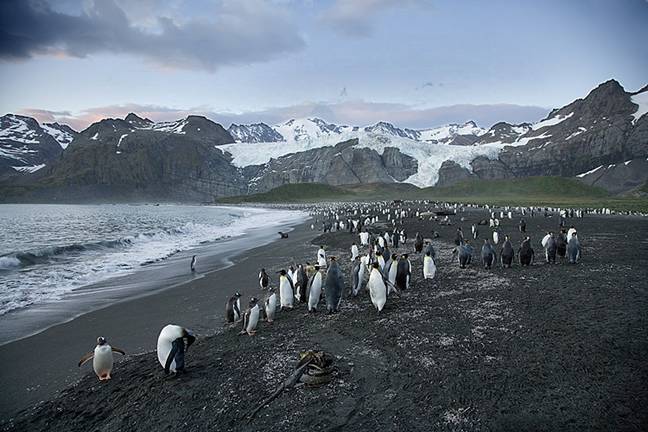
BIRDS AS ART BULLETIN #221
January 28, 2007
Visit: www.birdsasart.com
FALKLANDS, SOUTH GEORGIA, ANTARCTICA (F/SG/A) TRIP REPORT
THOUGHTS AND RETROSPECTIVES ON THE TRIP
COMING SOON: ANTARCTICA PHOTO-TRAVEL GUIDE
IPT KUDOS
TWO NEW IPTs SCHEDULED BY POPULAR DEMAND
THE DIRT ON LENS PENS!
GALAPAGOS 2007
NYC SEMINAR
ADDITIONAL EVERGLADES NATIONAL PARK ONE DAY IN-THE FIELD WORKSHOP ANNOUNCED
BIRDS AS ART/GUSTAPHOTO AFRICAN PHOTO SAFARIS
HUNT’S SPECIALS
IPT UPDATES
Contact us by phone at 863-692-0906 (Eastern Time Zone) or by e-mail at birdsasart@att.net or birdsasart@verizon.net. The att e-mail address is best from overseas.
We gladly accept credit card orders by phone 8am till 9pm Eastern Time (8 am till 3pm Fridays).
You can use the Paypal links on the web site to order anything. Just type in the item(s) and the amount. If using your own Paypal account, please send to either of the e-mail addresses above.
Photographic theme: Some of my favorite images from the recent F/SG/A trip.

Gold Bay, South Georgia
Image Copyright 2007: Arthur Morris/BIRDS AS ART
Canon 24-105mm IS L zoom lens handheld at 24mm with the EOS-1Ds Mark II. ISO 400.
1/100 sec. at f/4 set manually after histogram check.
Here I used the two penguins in the lower left corner and the kelp on the beach as compositional anchors making sure not to cut off the strip of kelp at the bottom. Care in framing separates good photographers from sloppy ones. .
FALKLANDS, SOUTH GEORGIA, ANTARCTICA (F/SG/A) TRIP REPORT
In the hotel that night, I came down with a sore throat… After breakfast on the 6th, we flew to Port Stanley, Falkland Islands. That evening, we boarded the Clipper Adventurer. (By this time, I had lost my voice completely. I had a nasty virus and with the relatively cold weather and great physical exertion I had two weeks of coughing at night and as I type this Bulletin on my home-office computer in Florida, I am still a bit congested. I was kind enough to pass it on to at least a dozen others including Peter Harrison. Sorry guys!) My berth was both roomy and comfortable. I should have mentioned already that I was leading a photography group for Janie Bullard of Distinctive Journeys (www.distinctive-journeys.com). There were 11 serious photographers in my group, plus two spouses. We sailed south that night and made our first landing via Zodiac the next morning at Bleaker Island in the Falklands. The ride was wet and rough and the landing a bit tough, but we all managed fine with our equipment. We were greeted by hordes of Gentoo Penguins, and there was a Gentoo rookery about a half mile up the hill, but most of us opted to concentrate on the Magellanic Penguins as this would be our only chance with them. We made our way down the beach to the right of the rocky slope where they were nesting in burrows and were delighted to see that many had large chicks. Along the way we saw Upland Goose, skua, White-rumped Sandpiper in winter plumage, Two-banded Plover, Rufous-chested Dotterel, Magellanic Oystercatcher, Falkland Steamerduck, Striated Caracara, Kelp Gull, Dolphin Gull, and Tussockbird among others. Anxious to get to the penguin colony, I stopped infrequently to photograph only a few of these species. In addition, we never reached a fresh water pond that was reportedly filled with various waterfowl species… Partly cloudy skies brightened during the two hours of our stay and photography conditions worsened over time, but many wonderful images were created that first morning (despite the increasingly harsh light).
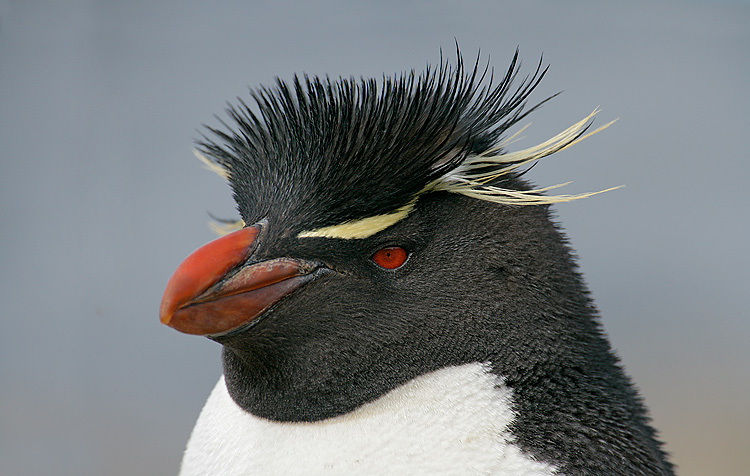
Rockhopper Penguin, Sea Lion Island, Falklands
Image Copyright 2007: Arthur Morris/BIRDS AS ART
Canon 500mm f/4L IS lens with 2X II TC and EOS-1Ds Mark II. ISO 400.
Evaluative Metering -1: 1/640 sec. at f/11.
To make this image I shortened the legs of my tripod and sat in the mud, muck, and guano. Most of the birds were sitting relatively still, but almost every time that I saw one with a relatively clean bill and sat down, the bird would waddle off ruining either the sun-angle or the background… I was glad to come up with this one. I did remove lots of gunk from the bill using the cloning and patch tool techniques detailed in the Digital Basics file: http://www.birdsasart.com/digitalbasics.htm
…..
We sailed for less than three hours, had lunch, and made our second landing at Sea Lion Island, also in the Falklands. “It’s a short walk up a gentle hill to the Rockhopper Penguin colony,” they said. Not exactly. Not with a 500mm lens on your shoulder and 30 pounds of stuff in your vest. We walked nearly 1 ½ miles up a fairly steep grade to the rockhoppers. Several of us found the walk challenging. Just before the rockhoppers there were 100s of mound-type nests, the remains of last year’s Imperial Cormorant colony. Just beyond that we were delighted to find a few hundred of the snazzy Rockhopper Penguins—many with chicks—in a relatively small area. We had mixed clouds and sun; the photography was great when it was cloudy and difficult when it was sunny. Despite my protestations, many in the group worked way off of the proper sun angle when the clouds parted… After about 90 minutes it clouded over. I had learned that there was a new Imperial Cormorant colony just a few hundred yards past the rockhoppers and even though we did not have much time left, I headed for the colony. It was amazing; there were hundreds of pairs, most with chicks. In ten minutes I made several family jewels and wound up keeping more than a dozen images. Fortunately, I spent so much time photographing that the Zegrahm’s folks arranged a ride back to our landing beach with a local farmer. I was saved…
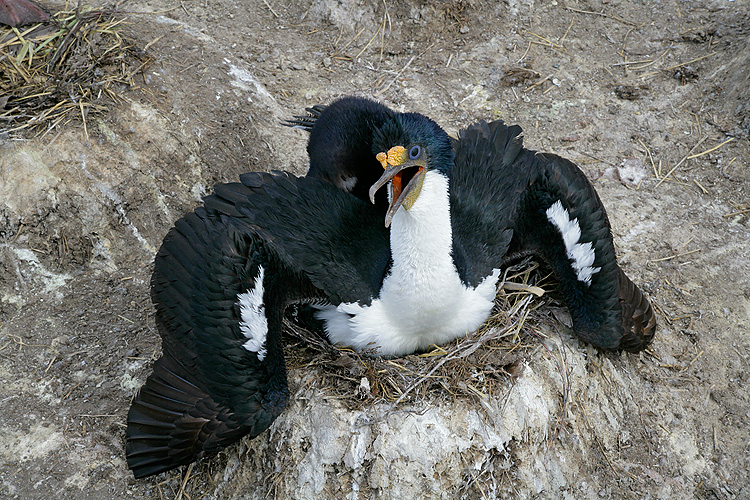
Imperial Cormorant (Shag), nest threat display, Bleaker Island, Falklands
Image Copyright 2007: Arthur Morris/BIRDS AS ART
Canon 24-105mm IS L zoom lens handheld at 70mm with the EOS-1Ds Mark II. ISO 400.
Evaluative Metering at zero: 1/100 sec. at f/22.
I had been making images of rows and rows of birds on the nest with lots of depth of filed but was so much in a hurry here that I neglected to choose a larger aperture which would have given me a much faster shutter speed. A relatively still subject and Image Stabilization saved the day.
…..
We sailed east towards South Georgia that night and did the same for the next two days. For the most part we had relatively calm seas throughout the trip and the thought of seasickness never entered my mind. There were usually four lectures on each sailing day. The Zegrahm Expedition leaders and Stanford lecturer Rob Dunbar were all superb presenters. There were so many great programs that it is hard to pick my favorites, but Ingrid Nixon’s Ernest Shackelton story was fantastically told. She began and ended with a quote: “Men wanted for hazardous journey. Small wages, bitter cold, long months of complete darkness, constant danger, safe return doubtful. Honour and recognition in case of success. " (I am sure of the exact quote: I have the T-shirt!) You can learn more about Shackleton’s Endurance Expedition (and the incredible rescue) by clicking here: http://www.south-pole.com/p0000098.htm
On the morning of January 10th, we landed at Salisbury Plain, South Georgia. The plain, flanked by two glaciers, is home to thousands and thousands of King Penguins. Lured by tales of photographic glory by Peter Harrison, a friend and I decided to hike to the top of a hill in order to be able to look down upon the rookery. At this point it is imperative that I introduce you to tussock grass which grows in tussocks—amazing no? Well there are these mounds of tough grasses about a foot higher than the surrounding vile muck and a foot or two in diameter. With each step you have to decide whether to step up onto the grassy mounds or to traverse the vile mud. Lots of fun. Did I forget to mention that when you step down from a tussock onto what looks like mud you might actually be stepping into a hole as deep as several feet? And that these mud holes are often totally covered by tufts of grass? We carefully made our way through several hundred yards of these lovely grasses. With the big lenses, it was tough going. My worst moment occurred when I unknowingly stepped into an unseen 18 inch deep hole. I pitched forward and fortunately the hole was wide enough so that I did not break either my tibia or fibula. Lucky me. I did see one of the older members of the Expedition fall over backwards into a four inch deep puddle of mud, muck, and guano, but he was quickly helped to his feet and appeared none the worse for wear. Once we made it through the first batch of tussock grass we had to decide whether or not we would climb the “little hill.” We decided to go for it. Big mistake on my part. I guess that the hill was maybe a thousand feet straight up; maybe a bit less, maybe a lot less. In any case it might as well have been Everest to me. Without the lingering virus, the big lens, and the heavy vest it would not have been too great a task, but with being sick, being over-dressed, and carrying all the gear, I was only able to take twenty or thirty small steps at a time before having to stop for a rest, heart pretty much pounding out of my chest. We made our way up rocky switchbacks and treacherous fields of scree—rock fragments that are have been broken off by the action of frost. Once we made it to the top of the first hill we stopped to make a few images, but it was obvious that the next hill over presented a better vantage point so down and up we went again.
At this point I was totally exhausted and more concerned about getting down safely than making great images. At one point I sat down just above rows and rows of King Penguins sitting on eggs. I realized that the best lens for the job would be the 24-105 IS L lens that was in a wool cap in one of the big pockets of my custom made X-tra Hand vest (http://www.birdsasart.com/bn61.htm) and (http://www.vestedinterest.com/about.htm). As I took the lens out of the wool cap, I was so tired that it simply slipped from my hand and rolled down the hill past about eight rows of nesting penguins. What to do? I was not thrilled at the thought of leaving my brand new $1700 all purpose/grab-shot lens atop Salisbury Plain. Already seated I simply wriggled my way down the hill on my rear and then wriggled back up the hill to my gear while remaining on my butt. Amazingly, the birds were so tame that not one left its nest. I made a few images and headed down hill, still more than exhausted. Within a few moments I came to a small angled scree slope. I was dizzy and weak but there was nowhere else to go. And the Zodiacs were already taking folks back to the ship. It looked as if I would still have a mile to go after making my way down to the flats… Using my tripod as a walking stick I traversed the rocky slope well aware that a fall down the ridge to my right would surely result in either severe injury or death. I was relieved when I made it safely, but the “path” swung back to the right through—you guessed it—another area of tussock grass. At this point I was pretty much out of gas. I fell five times while making my way downhill through sixty yards of tussock grass, but all of the falls were gentle ones.
Once I made it down to the flats I realized that I was going to live and with renewed energy headed back to the landing and departure beach, stopping only to photograph a Brown Skua chick.
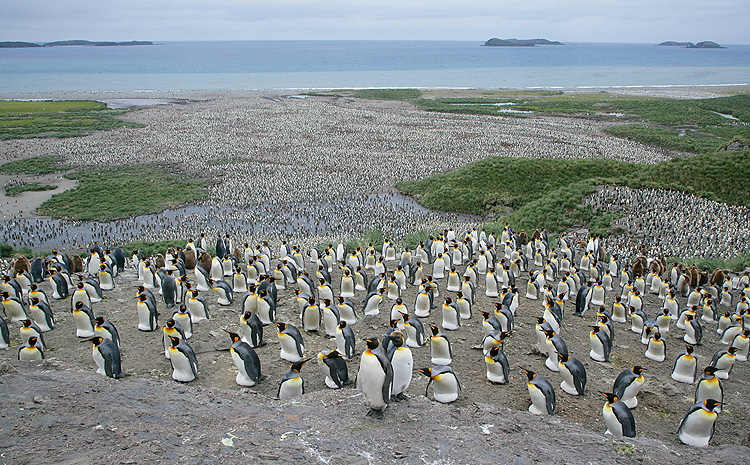
King Penguin colony from above, Salisbury Plains, South Georgia
Image Copyright 2007: Arthur Morris/BIRDS AS ART
Canon 24-105mm IS L zoom lens handheld at 28mm with the EOS-1Ds Mark II. ISO 400.
Evaluative Metering at zero: 1/125 sec. at f/22.
This is the image that I created after retrieving my 24-105 which had rolled into the colony. Was the image worth my near-death experience climb? I will let you be the judge. Here again IS let me use a relatively slow shutter speed so that I could have lots of depth of field.
…..
The ship—I was reprimanded several times for calling it a boat—made a wiggle and anchored off of Prion Island. I napped just a bit after lunch; the regenerative powers of sleep are amazing. We would be landing and climbing a small but nasty hill, and nearly all of the climb would be through tussock grass which turned out to be far muddier than any we had encountered previously. Atop the small knoll at Prion Island was a small colony of Wandering Albatross. ““I now belong to a higher cult of mortals, for I have seen the Albatross” --- Robert Cushman Murphy, Logbook for Grace. Having heard this quote from Peter Harrison during his wonderful albatross slide program, and learning that this site would be closed for at least a year so that a glass-enclosed boardwalk and viewing platform could be constructed, there was no way I was going to miss this landing. The climb was short but tough, the birds amazingly huge and totally tame. Peter, who is totally against the new plan to “protect the birds"—very few ships make this stop—was visibly upset knowing that this would be his last visit to the colony in its natural state. Peter took great delight in sharing both the birds and his great knowledge of them with the group. Time after time he accurately predicted their various courtship behaviors. The descent was nasty with several folks falling on the slick mud. I think that this is where we had our first broken ankle… I took the easy way down, on my butt. (On the way down, I had good views of South Georgia Pipit, the southern-most passerine in the world.) Needless to say, I slept long and well that night.
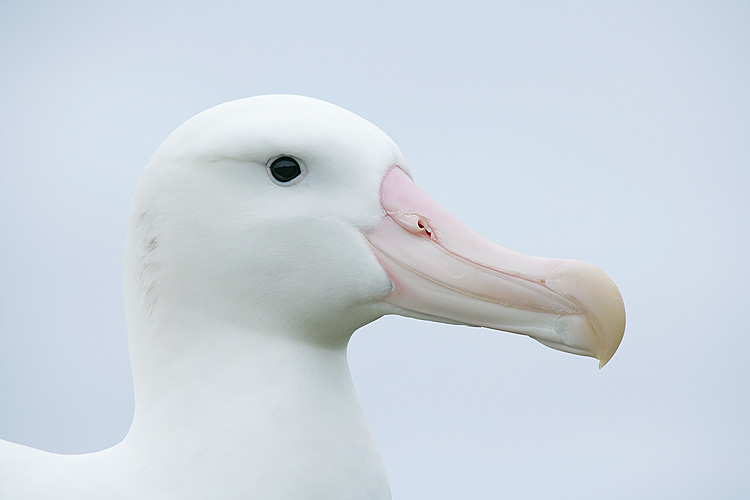
Wandering Albatross, head portrait, Prion Island, South Georgia
Image Copyright 2007: Arthur Morris/BIRDS AS ART
Canon 100-400mm I L zoom lens handheld at 400mm with the EOS-1Ds Mark II. ISO 400.
Evaluative Metering +1 stop: 1/320 sec. at f/10.
I lay in the wet grass to ensure a white sky background here as I thought that it would go well with the all white adult bird. Because I was working at point blank range I chose a relatively small aperture so that the extra depth-of-field would cover the entire head and bill from front to back. The 100-400 was extremely valuable on the F/SG/A trip.
…..
On Thursday the 11th we were supposed to make an early landing at Hercules Bay to photograph Macaroni Penguins, but it was windy and raining hard so the landing was cancelled. I cannot say that I was disappointed… We proceeded to Grytviken, South Georgia, and though it was raining, most folks went ashore to make a toast at Shacklelton’s grave and visit the old whaling station and museum. I—and a very few others—went ashore to photograph the wildlife which included Antarctic Fur Seal, Southern Elephant Seal, South Georgia Pintail, and a few King Penguins. We sailed back to Hercules Bay but again conditions made landing impossible so we continued on to Fortuna Bay. Many Zodiacs laden with long hikers landed here so that they could walk the last 5 miles or so Shackleton’s historic trek across the mountains of South Georgia to the whaling station in Stromness Bay to get help for his men. We were told that there was a another great King Penguin rookery at this site. As I was still exhausted from the hike above Salisbury Plains and it was raining and the walk to the King Penguin rookery was about 1 ½ miles and we had another landing scheduled for later that day, I decided to skip this landing. One of the members of the group got an amazing sequence of a pair of copulating King Penguins with a lovely background of green grass… Later that day we landed at another old whaling station at Stromness to pick up the long hikers, one of whom had broken an ankle. There were lots of Antarctic Fur Seals (including an albino baby that played extremely hard to get and some King and Gentoo Penguins. Very late in the day the sun came out on the hills at the entrance to the harbor. Too soon it was back to the ship. After another great (but rather late) dinner the wake up call at 3am came much too soon, but there was no way that I was going to miss the sunrise and all the incredible wildlife at Gold Bay.
On the morning of the 12th we landed at Gold Bay just at sunrise, a bit after 4am I think. Before us lay one of the great wildlife spectacles on the planet. As we came ashore there were stacks of huge Southern Elephant Seals, thousand of nesting King Penguins, hundreds of “Oakum Boys,” the young kings from the previous nesting season (most had left for the sea during the preceding month), hundreds of Gentoo and King Penguins jumping in and out of the surf, Brown Skuas and Giant Petrels ripping apart the carcasses of the young kings that did not make it, Snowy Sheathbills scavenging the leftovers, and a wonderful colony of Gentoo Penguins. In order to get to the gentoo rookery you had to traverse some nasty tussock grass, thread your way along the boundary line between the rookery and some very nasty male fur seals all the while trying to avoid falling into the elephant seal wallow pit. None-the-less, it was a piece of cake compared to Salisbury Plains… At about 8am, I was enticed to climb another tussock hill in hopes of photographing Light-mantled Sooty Albatross on the nest. The bird was tucked in facing the hill behind a wall of grass but I managed one decent head portrait. “There are better nests higher up” said Peter. I passed on those. It was on this decent that we had our second broken ankle… I must say that each of the two gentleman with the broken ankles had great attitudes: they did not make any additional landings after their mishaps, but took many Zodiac rides and took part in virtually all of the on-ship activities. We had many long and wonderful hours ashore at Gold Bay and the prevailing bright overcast conditions were perfect for photography. I made many of my favorite images on this landing.
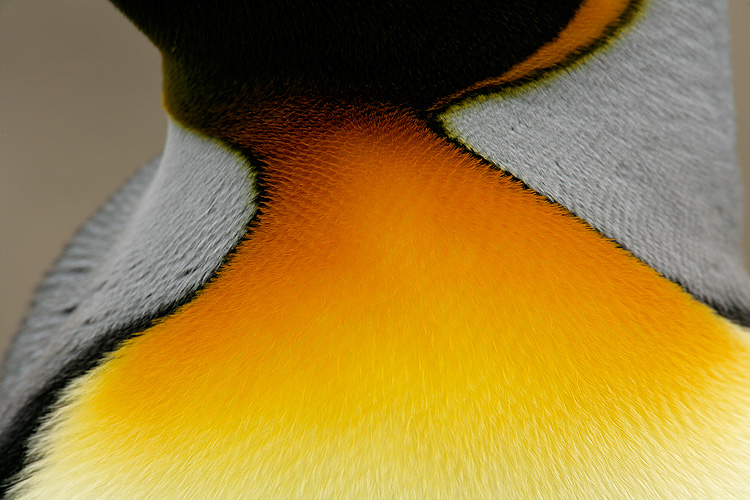
King Penguin, feather detail, Gold Bay, South Georgia
Image Copyright 2007: Arthur Morris/BIRDS AS ART
Canon 500mm f/4L IS lens with 2X II TC and EOS-1Ds Mark II. ISO 400.
Evaluative Metering +1/3 stop: 1/200 sec. at f/16.
When folks ask me why I brought the 500 to the Southern Oceans when the birds are so tame I will show them images like this. Again, when working near minimum focusing distance it is important to use a small aperture as depth-of-field at the wide open aperture is measured in mere fractions of an inch.
…..
We set sail for Cooper Bay at the far western end of South Georgia and had lunch. The wait staff, the room attendants, and the deck hands were almost all Philippino and each and every one of them was delightful and helpful. I did not have time for even a short nap before we landed and made another short but nasty climb up to a Macaroni Penguin colony but bright sun made photography near-impossible. I kicked myself for not remembering to bring my flash… Realizing that discretion is the better part of valor I once again slid all the way down through the tussock mud on my rear end. That late afternoon I lay in bed listening on the loudspeaker system to the beauty of Drygalski fjord where the captain reportedly maneuvered the ship with great skill right up to the base of the glacier, but try as I might I simply did not have the strength to get out of my bed, grab a camera, and head up on deck.
On the 13th we sailed across the South Scotia Sea headed for the South Orkney Islands. On the early morning of the 14th I began having coughing fits at 2am and could not sleep so I went up to the lounge to work on pictures and do some reading. I finally stopped coughing and fell asleep on the padded bench seats and woke at about 6am. By 9am we were anchored off of Coronation Island and learned that we would not be able to make any Zodiac landings because there were too many fur seals on the beach. This turned out to be a blessing in disguise as we opted for some Zodiac cruising instead and came upon two groups of Chinstrap Penguins on a small iceberg. Obet, our Zodiac driver, held the boat in position perfectly and all on board—including and especially me—created many wonderful images. It was one my favorite photo opportunities of the trip. The weather took a turn for the worse as we headed west towards Elephant Island.
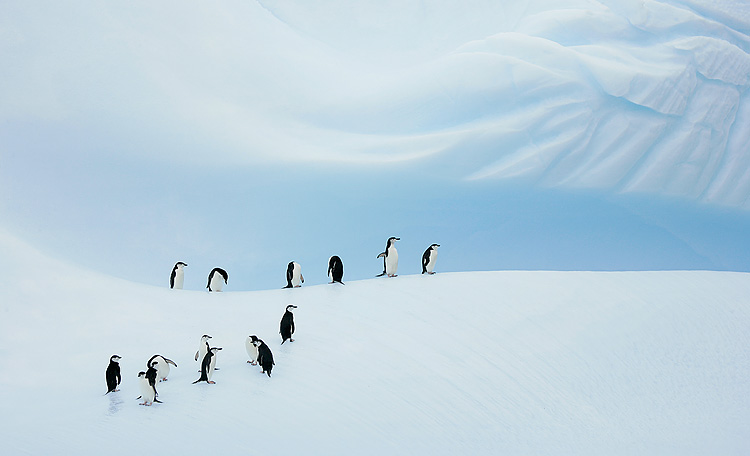
Chinstrap Penguins on blue iceberg near Coronation Island, South Orkney Islands
Image Copyright 2007: Arthur Morris/BIRDS AS ART
Canon 100-400mm IS L zoom lens handheld at 180mm with the EOS-1Ds Mark II. ISO 400.
Evaluative Metering +1 2/3 stops: 1/1600 sec. at f/8.
Many folks firmly believe that a long lens is always best but that is obviously incorrect. You need to consider the scene before you and then ask yourself, what do I love about what I see? Here the patterns and color of the ice screamed out, “Include us!” Note the compositional balance with the birds in the lower right and the sculpted ice in the upper right. Learn more about advanced composition and image design in ABP II: http://www.birdsasart.com/ABPII.htm
…..
The 15th was a rather uneventful day. Some folks made the difficult landing at Wild Point on Elephant Island where Shackelton left most of his crew to await rescue as he sailed across fierce seas in a tiny boat back to South Georgia. Most of us just took the Zodiac cruise; though there were many Chinstrap Penguins on the rocks, the bright sun once again made creating good images an almost impossible challenge.
We woke on the 16th to find the decks covered over with ice and a gentle snow falling. Photographically this turned out to be my favorite day of the entire trip. We made our first landing at Brown Bluff; we had made it to the Antarctic Peninsula, had landed on the seventh continent. I skipped the champagne opting instead to photograph the Adelie Penguins frolicking and feeding chicks in the falling snow. We had wind gusts up to 45 mph. When we landed on Paulet Island that afternoon the snow and wind continued. There were adelies jumping off and onto icebergs not too far from shore and a wonderful colony of breeding birds, Blue-eyed Shags (Cormorants) on the lower part of the hill, and Adelie Penguins above them. I could not resist pointing the 500 a bit into the wind to photograph the adelies on the icebergs and within minutes the front element was covered with slush so I switched to the handheld 70-200 with a 1.4X TC and the Mark II 1Ds; it was much easier to protect a handheld lens from the elements as you could put your back to the wind. We were able to make some great images of the cormorants landing and the birds were so tame that head portraits were possible even with a maximum focal length of 280mm.
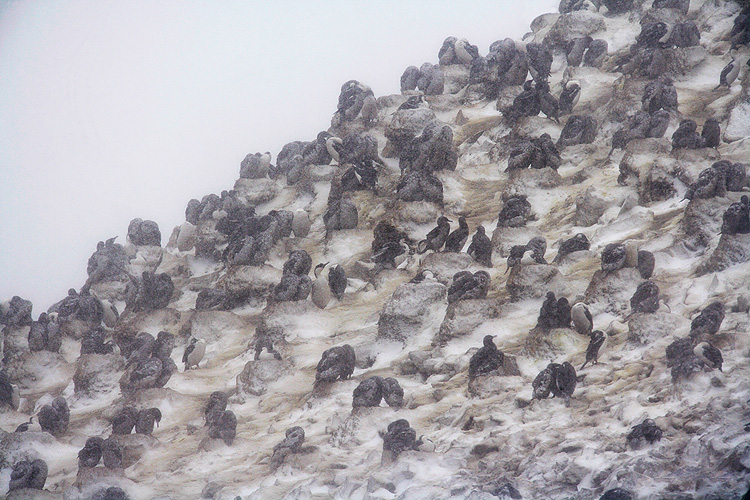
Blue-eyed Shag (Cormorant) rookery in summer snow storm, Paulet Island, Antarctica
Image Copyright 2007: Arthur Morris/BIRDS AS ART
Canon 500mm f/4L IS lens with 1.4X II TC and EOS-1Ds Mark II. ISO 400.
Evaluative Metering +1 stop set manually: 1/400 sec. at f/8.
I saw this image as we got off of the Zodiacs but there were so many amazing subjects at hand that I did not get around to creating it until we were ready to head back. I guess the slush on the front element added to the surreal quality of this image…
…..
The morning of Wednesday the 17th again found the decks icy and windswept. The crew explored the possibility of making Zodiac landings at several locations but a ten foot swell made it impossible to launch even a single boat. That afternoon the captain chose to make his way through the Antarctic Sound dodging icebergs of all sizes and shapes as we went. This saved us many hours of sailing and the scenery was superb.
Early on the 18th we were anchored off of Bailey Head, Deception Island. We were able to view the huge Chinstrap Penguin colony from the rear deck of the ship. The weather was bright overcast. We had not yet visited a Chinstrap rookery and were told that this would be our last good chance with this species. There were hundreds of chinstraps leaving and entering the water from a perfectly clean beach of green sand. Needless to say with the perfect conditions all of the photographers were quite excited. The long hikers would be landing first and then hiking up and over the outer edge of the caldera of an ancient volcano. The ship would meet them inside the caldera at Whaler’s Bay in several hours. Excitement was at a fever pitch as we headed towards the beach at Bailey Head. We were the next Zodiac to land. The boat in front of us gunned the engine and made its way well up onto the sand. This was necessary as the beach was steeply sloped and there was a good swell on. The landing party grabbed the Zodiac to hold it in place but the next wave, a high energy one, snatched the boat from their grasp and pulled it back into the sea despite their best efforts. The boat, having been pulled backwards by the fierce undertow, was completely swamped. They were able to land again and the last of the long hikers disembarked; we watched as the water was bailed out of the boat when our Zodiac driver answered a call on his radio. All of the remaining Zodiacs were ordered to return to the Clipper Adventurer. Our landing had been cancelled. Better disappointed then drowned…
A few folks and a number of the landing crew were still on the beach, and it took several hours to get them safely into the Zodiacs and back onto the ship. Kevin Clement, one of the Zegrahm’s staff, pushed the last boat safely off and then headed up the hill to catch up with the long hikers. Kevin is a gifted artist and quite the humorist; his lectures—especially the one on krill—left everyone in stitches. You can learn about krill here: http://en.wikipedia.org/wiki/Krill or here: http://www.enchantedlearning.com/subjects/invertebrates/crustacean/Krillprintout.shtml. Kevin delighted all by combining his two talents and posting natural history related cartoons on the white note-board at the front of the main lounge each afternoon.
We landed at Whaler’s Cove where many bathed in the geo-thermally warmed water along the shoreline, some daring to plunge into the icy waters. Though it was sunny again, some of the non-swimmers tried our hand at photography. The subjects included a very few penguins that had become lost in the caldera bay, some sea lions, and some Kelp Gulls with chicks. To make up for the morning’s disappointment, cruise director JD Massyn arranged a short-notice afternoon landing at Half Moon Island. After numerous pleading e-mails, this landing was made possible because another ship had been delayed by very bad weather on their Drake Passage crossing. Though the skies were clear and the sun bright, it was late enough in the day to create some nice images of the Chinstrap Penguins and their chicks. And this time I remembered my flash. Lots of folks in our group spent a good deal of their time ashore concentrating on Antarctic Tern but I saw only a few scattered about and spent my time head-hunting the chinstraps…
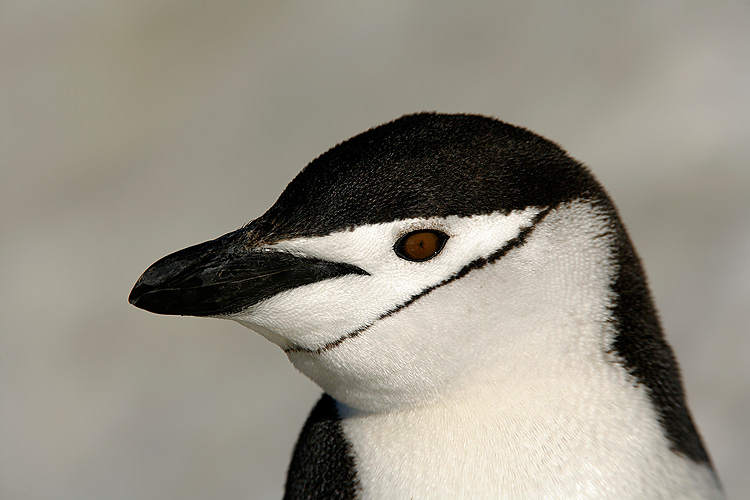
Chinstrap Penguin, head portrait, Half Moon Island, Antarctica
Image Copyright 2007: Arthur Morris/BIRDS AS ART
Canon 500mm f/4L IS lens with 1.4X II TC and EOS-1Ds Mark II. ISO 50.
Evaluative Metering -1/3 stop: 1/250 sec. at f/11 in Program Mode. Fill flash at +1 stop.
When using flash as fill in bright sun setting the flash at +1 stop will eliminate the harsh shadows. The background here consisted of distant gray rocks that were far enough away to remain out of focus even at f/11. Note the use of Program Mode when using flash in bright situations and note that I chose ISO 50 to avoid sharpening up the background rocks! Using a higher ISO in Program Mode would have resulted in a much smaller aperture.
…..
The morning of the 19th dawned clear and bright as we sailed through the gorgeous and scenic Errera Channel. We had been called to deck early as the captain had spotted a Humpbacked Whale lunge feeding and some Orcas chasing penguins. As the whales were quite distant, I opted to handhold the 400 f/5.6 with the EOS-1D Mark IIN, and with sun on the subjects, I uncharacteristically chose f/10. After making more than a few so-so images I had the lens pointed at the fin of the lone humpback when I heard loud screams from the folks above and around me—I was working near the bow. I looked down and saw a penguin six inches in front of an Orca. I lowered the camera, focused and made two images just after the Killer Whale had taken the penguin literally right from under my nose. When fifty folks shouted at once, “Artie, did you get that?” I responded sheepishly, “I am pretty sure that I did not.” The two images showed nothing but the splash. Because I had been at f/10 and the attack took place in the shadow of the boat, my shutter speed had been only 1/125th sec. so the images were not very sharp. Had I had the 100-400 in my hand and had the humpback not surfaced when it did, I would have been famous for sure… You gotta love it.
After that adventure we made our way to the spectacular Paradise Bay for some Zodiac cruising. It was bright sun and our Zodiac did not see much besides icebergs, glaciers, and geological features but another Zodiac—captained by Shirley Metz—had a great time with a point-blank Crab-eater Seal and a Gentoo Penguin colony. You gotta love it.
After that we sailed down the scenic Lemaire Channel and anchored near Pleneau Island for some more Zodiac cruising. We saw lots of Leopard Seals on ice but all they did for us was sleep. Many of the point and shooters on the ship came by to show me images of these same animals with their large reptilian-looking heads raised and their huge maws—filled with sharp teeth—opened wide. You gotta love it. We did have some nice cloudy bright weather and some nice Crab-eater Seals. After we were done with the seal photography I asked Ingrid to position the boat a bit offshore of a Gentoo Penguin colony set among lovely gray rocks. After that we had some good chances with Blue-eyed Shag (Cormorant). I must mention that the 100-400 IS L Image Stabilized lens was perfect for photography from the Zodiacs.
Later that afternoon we were offered a landing at Petermann Island and I jumped at the chance after hearing the description. I brought flash for the first time in low light and without too much effort made some great images of Adelie Penguins and Adelie chicks and Antarctic Shag (Cormorant). I was more than glad that I went.
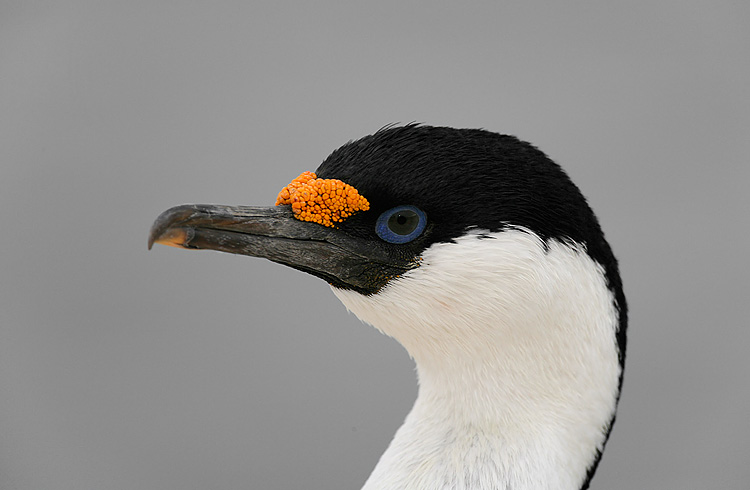
Antarctica Shag (Cormorant), head portrait, Petermann Island, Antarctica
Image Copyright 2007: Arthur Morris/BIRDS AS ART
Canon 500mm f/4L IS lens with 1.4X II TC and EOS-1Ds Mark II. ISO 400.
Evaluative Metering +2/3 stop set manually after histogram check: 1/125 sec. at f/6.3. Fill flash at -2 stops.
With the often-windy conditions and the tame birds I did not use my Better
Beamer on the trip. Note the perfect head angle here with the bird turned
slightly towards the imaging sensor. .
…..
I—and most of the photo group—skipped the Zodiac cruises at Enterprise Island the next morning because of bright sun and the fact that the primary photographic subjects were rusting grounded whaling vessels. I showed most of the group how to make reduce color casts in the blacks of the penguins and cormorants using by making either Hue-Saturation or Selective Color Adjustments. Our last Zodiac landing on the afternoon of January 20th was to be our last so in spite of the bright sun I opted to go. It turned out to be one of our most exciting (and dangerous) landings.
The wind was about 45 mph as we boarded the Zodiacs and the trip to the beach was rough and wet. There were large clouds all about but—unfortunately—the sun managed to avoid them for the most part. There were sections of a large Gentoo colony to the left and the right and I headed left though I was not sure why. With the bright sun and with winds gusting to more than 50mph photography was difficult to impossible. After a fruitless hour I headed back to my Roadrunner AW bag to get my flash. The wind had dropped out almost completely. As I photographed a skua scavenging a small penguin chick the wind increased, and within minutes, it was howling. I lowered my tripod to ground level in an effort to get out of the wind and had a nice backlit image of a gentoo with two chicks set up when one of the leaders tapped me on the shoulder and told me that we had been ordered back to the ship. Good plan. On the short walk back to the landing site I was almost knocked down several times. We learned later that the wind had been a steady 50 mph with gusts to 75 mph, and you really felt those gust.
Getting the Zodiacs to the beach was tough as the deck hand on the lee side of the boat had to struggle fiercely to hold the boat in place and avoid being knocked down and under the Zodiacs. How they managed to do it I will never know. I was in the third from last boat to head back to the ship and the water was seething with horizontal spray being blown everywhere. It was great to get back on the boat with all of my gear and my person safe and dry. After each Zodiac unloaded their passengers the boat was hoisted up by a large crane and winch system and stowed away on one the upper deck. One Zodiac was needed to return to the beach, pick up the landing crew, and get them safely aboard. Russell Evans, a sixth generation Falkland Islander and obviously a skilled Zodiac driver, was selected for the task. There was a great danger that his empty boat would simply be flipped in the air and over-turned as Rusty headed into the beach, so the chief engineer was given a seat in the bow of the Zodiac as ballast. Within ten minutes all hands were safely on board and we set sail north for Ushuaia, Argentina with the dreaded Drake Passage to come.
I spoke to Rusty afterwards curious as to whether he had been in any real danger. He explained that if his Zodiac had flipped with all of the other Zodiacs already stowed away on the big ship he—and anyone with him—would have been dead long before help could have arrived. In the 34 degree water, you have less than four minutes to live before hypothermia gets you and re-launching a rescue boat in the rough seas would have taken a lot longer than that.
The captain ordered the shutters placed on the bow windows in the Main Lounge as the high winds continued and we began our long sail north. It was a bit rough during dinner but within an hour or two it was relatively calm. Our calm seas-luck held for the next two days and the next evening the Drake Passage had become the Drake Lake. I put together a slide program of more than 200 of the group’s favorite images and John Bryant graciously agreed to add and synchronize the music. He did a superb job; the show was presented on our last afternoon aboard the Clipper Adventurer. The response was amazing; nearly everyone on board attended an virtually everyone who saw the show wanted a copy. We set up a sheet and more than 80 folks left their name and e-mail addresses. For more than two weeks these folks had seen us packing our dry bags with gear, struggling with them on the Zodiacs, and lugging our big lenses up and down hills and through stinking guano pools. To most of them a 300 was a big lens, and most of them had no clue as to what we were doing and why. After the program, they knew. I was very proud of all of the boys and girls: Carol Walker, Cindy Marple, Hal DuPont, John Sturtevant, Doug Holstein, Greg Ferguson, Isobel Wayrick (who had made the Emperor Penguin trip just two months before!), and the afore-mentioned John Bryant of George, South Africa. The strongest image in the show was most likely John Bryant’s head shot of an Elephant Seal exhaling a foggy breath.
I neglected to mention above that on some of the days at sea we had some good flight photography opportunities from the ship, usually on the rear deck. Subjects included Black-browed and Wandering Albatrosses, Northern and Southern Giant Petrels, and Pintado (formerly Cape) Petrel (among others). In addition, we got to photograph some great icebergs from the big ship as we cruised from one spot to another.
After docking in Ushuaia on the early morning of January 23 we disembarked at 9am for a short city tour and a show put on by a local gaucho dance team. I was not too excited as we sat in a big somewhat smelly barn—we had seen some of their beautiful horses as we entered—waiting for the performance to start. Suffice to say, everyone was totally blown away by the dancing which was reminiscent of and as energy-filled as Stomp.
Then it was off to the airport. Four flights and about 26 hours later I was safely on the ground in Orlando, FL.
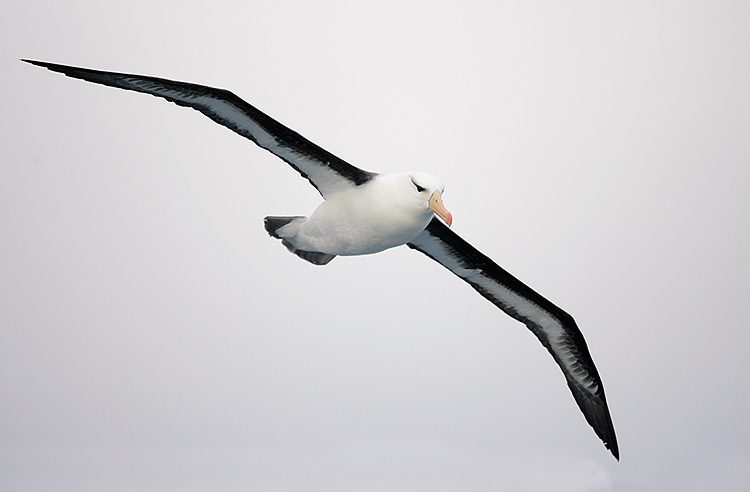
Black-browed Albatross, cruising off South Georgia
Image Copyright 2007: Arthur Morris/BIRDS AS ART
Canon 500mm f/4L IS lens handheld with EOS-1D Mark IIN. ISO 500.
Evaluative Metering +1 2/3 stops off of white sky: 1/800 sec. at f/4.
Hand-holding the 500 IS was a fairly obvious choice as using a tripod would have transferred the vibrations of the ship’s engines from the deck to the lens. I went to ISO 500 for a bit of extra shutter speed. Whenever we had white skies I taught the group that metering off the white sky and adding 1 2/3 stops of light would result in perfect exposure for these black and white birds. Check out Exposure Simplified in ABP II: http://www.birdsasart.com/ABPII.htm. “When the sun is not out, the meter is dumb; the whiter the overall scene, the more light you have to add!”
THOUGHTS AND RETROSPECTIVES ON THE TRIP
All in all it was a fantastic trip. An amazing trip. Somewhat grueling for this old bird photographer, but still fantastic. The Zegrahm’s folks were skilled and knowledgeable. They worked hard to make sure that everything went smoothly and it always did. Getting about a hundred folks on and off the Zodiacs dozens of times often in high winds and high seas is no easy trick, yet there was not a single fall or injury on any of the landings. Credit goes all the way from the expedition leaders (JD—mentioned above—and Lynne Greig) down to the deck hands each of whom helped and instructed us each time we got in or out of a Zodiac. As I said previously, all of the lecturers were skilled and interesting. Geoff Renner, a geologist from the UK, gave lots of us an appreciation for and understanding of rocks. And just hearing him say the word “Antarctica” with his perfect English diction was worth the price of the trip. I practiced and practiced saying it just the way he did: ”ant-TAHRCK-tick-KUH.” Rick Price, a veteran Antarctic researcher, presented several interesting programs as well. My favorite was the one in which he described his experiences over several seasons of research, half of which was done during the unforgiving Antarctic winters. As noted above, the staff and the captain (there was an open bridge policy on the Clipper Adventurer) were fantastic.
Meeting, working with, and listening to Peter Harrison was one of the great highlights of my life. And Shirley was no slouch either <smile>
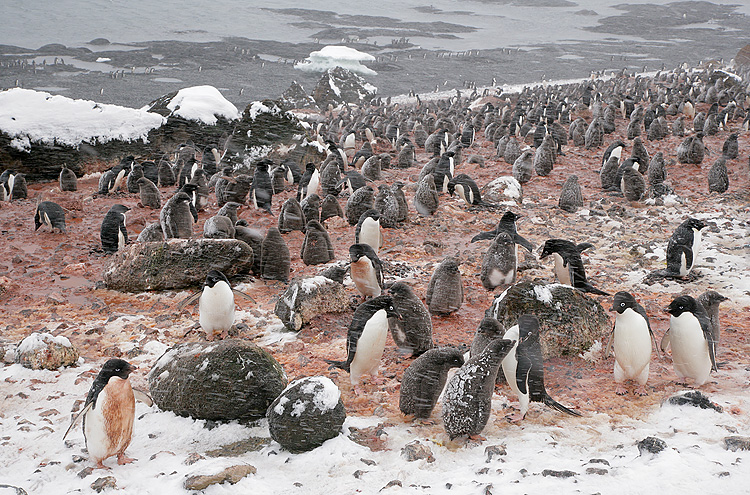
Adelie Penguin rookery, Brown Bluff, Antarctica
Image Copyright 2007: Arthur Morris/BIRDS AS ART
Canon 24-105mm IS L zoom lens handheld at 55mm with the EOS-1Ds Mark II. ISO 400.
Evaluative Metering +2/3 stop set manually: 1/200 sec. at f/14.
A moment after I visualized and created this image several red-parka-ed folks walked down the beach from left to right…The extremely versatile 28-105 IS was oft-used and valuable on this trip.
…..
I knew in advance that this trip was designed to give folks just a taste of the wonders of the Southern Ocean. I am not sure that I will ever get back to the continent. It was often too windy or two sunny for photography, but that said, the day in the snow was pretty much the highlight of the trip for me… If I continue to be blessed by good health I hope to organize a trip for six or so folks to the Falklands. Our visit this incredible wildlife location was much-too-brief and somewhat rushed. A two to three week trip in December would yield countless photographic opportunities with a host of different species, many with tiny chicks. If you are interested in joining me on this trip, please shoot me an e-mail with Falkland’s 2008 in the Subject line.
I hope to continue to work with Zegrahm in the future and have my eyes on their next Circumnavigation of South Georgia Expedition. If I ever do this year’s F/SG/A trip again with Zegrahm’s, I would be better able to choose my battles and would surely avoid the hike up the hill behind Salisbury Plain <smile>
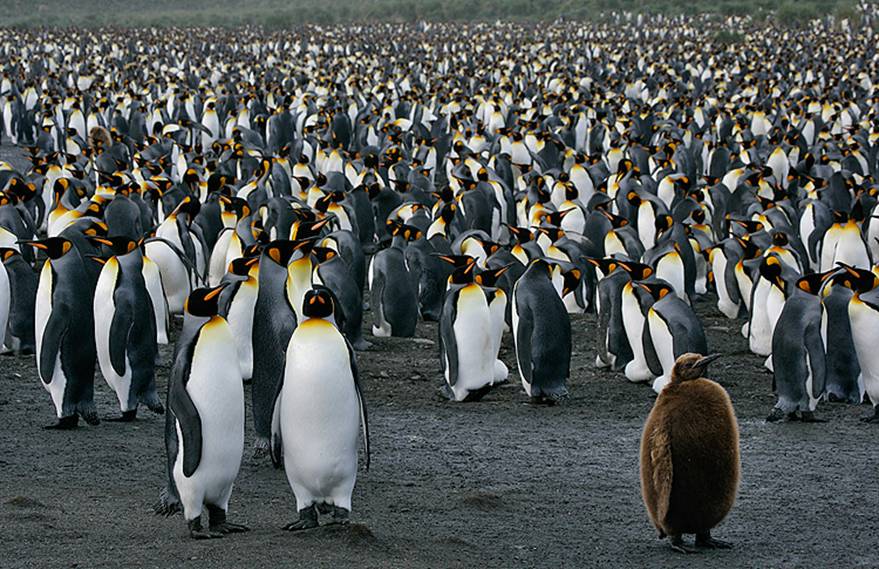
King Penguin colony with one Oakum Boy, Gold Bay, South Georgia
Image Copyright 2007: Arthur Morris/BIRDS AS ART
Canon 100-400mm IS L lens handheld at 150mm with EOS-1Ds Mark II. ISO 400.
Evaluative Metering +1/3 stop: 1/160 sec. at f/16.
The keys to the success of this image are the clean lower edge and the relatively clean upper edge. Images where the birds along the lower edge are cut in half do not work unless you are creating a pure pattern.
COMING SOON: ANTARCTICA/SOUTH GEORGIA/ FALKANDS (A/SG/F) PHOTO-TRAVEL GUIDE
I have never made a trip where planning what gear and clothing to bring was so vitally important not only to the photographic success of the journey but to the protection and safety of your gear and your person. By late March, I hope to be able to offer the BAA ANTARCTICA (A/SG/F) PHOTO-TRAVEL GUIDE. In addition to covering all of the logistical aspects of traveling to the Southern Oceans on a photographic expedition, this guide will offer extensive photography tips; these will include methods and techniques for working in difficult conditions, exposure tips for black and white subjects, and tips on creating pleasing compositions. More importantly, the guide will let you know how to keep your equipment safe and dry, how to get it safely to and from your home to the tip of South America, and how to keep it safe and dry while getting on and off the Zodiacs. The guide will be profusely illustrated and each image will feature our legendary educational captions. Advice given for specific sites will of course be limited only to the sites that I have visited. Should I return to any of the locations covered in the guide, we will—as always—offer free updates. I shall keep you advised of my progress in future Bulletins.
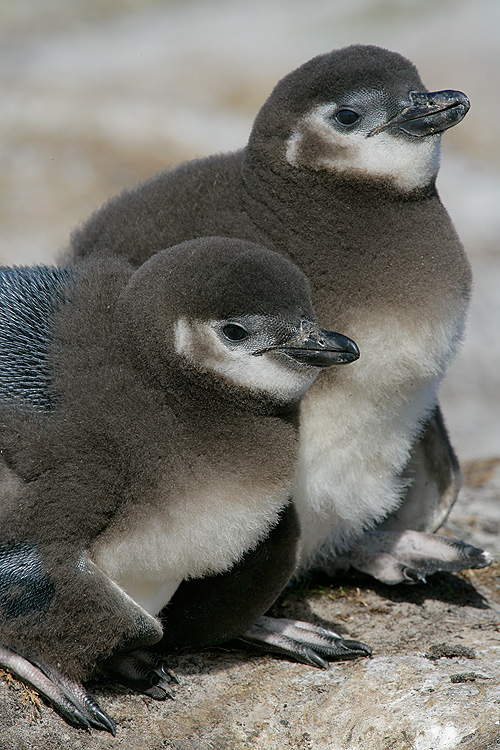
Magellanic Penguin chicks, Sea Lion Island, Falklands
Image Copyright 2007: Arthur Morris/BIRDS AS ART
Canon 500mm f/4L IS lens with 1.4X II TC and EOS-1Ds Mark II. ISO 400.
Evaluative Metering -1/3 stop: 1/400 sec. at f/16.
As the second bird walked past the first I quickly re-composed and made an image realizing that the success of the image depended on not clipping the toe of the rear bird. I just made it! Note the extra depth-of-field that ensured two sharp baby penguins. Focus (One-Shot AF with the central sensor) was on the eye of the front chick.
IPT KUDOS
An e-mail from Vince Lamb, Nikon user, IPT veteran, and Bulletin subscriber.
Hi Artie, I greatly enjoyed the Post Xmas IPT (which was my second IPT). My bird photography has clearly improved under your guidance. I look forward to substantial improvement as I take the concepts that I have learned from your tours (and your books) and try to apply them. I also appreciate the help provided by Alfred Forns and Robert Amoruso. Both Al and Robert are willing to share their techniques for getting outstanding images. Your assistants play a big role in the high quality of your instructional photo tours.
I have participated in a wide range of digital photographic instruction, including seminars conducted by Outdoor Photography, Nikon, and Adobe and attended photo tours led by other photographers. Your IPTs stand out as the best – both in terms of the useful techniques learned and the “fun factor” of spending a few days with you and your associates.
Best regards, Vince
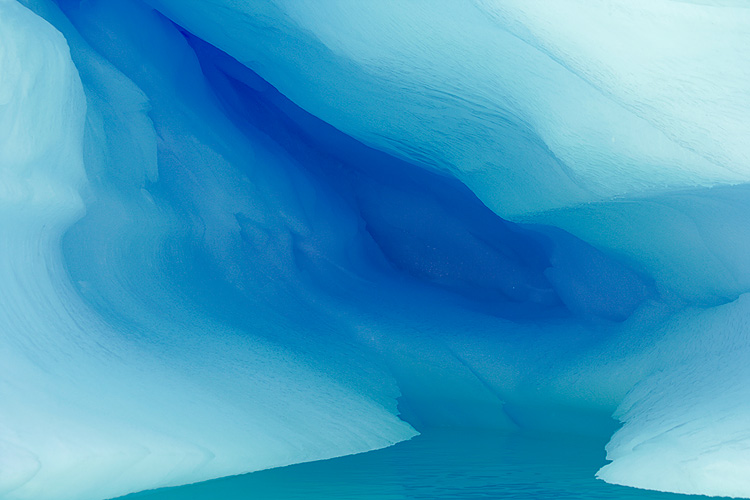
Blue ice cave in iceberg, Paradise Bay, Antarctica
Image Copyright 2007: Arthur Morris/BIRDS AS ART
Canon 100-400mm IS L lens handheld at 105mm with EOS-1Ds Mark II. ISO 320.
Evaluative Metering +1 stop: 1/500 sec. at f/8.
My goal here was to work tight enough to avoid including any of the sunlit portions of the iceberg in the frame. The 100-400 IS L zoom lens performed superbly when working from the Zodiacs.
TWO NEW IPTs SCHEDULED BY POPULAR DEMAND
As the Fort DeSoto IPT has been sold our for many months with a waiting list, I am offering a second Fort DeSoto IPT as follows:
Fort DeSoto IPT: APR 17-19, 2007. Slide program on the evening of Monday, APR 16. 3-DAY: $999 Limit 14. Co-leaders: TBD. Courtship and breeding behaviors of Laughing Gull and Royal and Sandwich Terns. Herons, egrets (including both dark and light phase Reddish Egret), shorebirds (including Long-billed Curlew), gulls, terns, and skimmers among others.
As many folks have asked about a 2007 St. Augustine Alligator Farm IPT, I am offering the following:
St Augustine Alligator Farm MAY 17-20, 2007. 3 1/2 DAY IPT: $1099 (Limit: 12) Introductory Slide Program from 2-4pm on the afternoon of Thursday, May 17. This IPT includes 7 photography sessions and four slide programs, with at least two devoted totally to Photoshop. Amazing heron and egret rookery. Nesting Great, Snowy & Cattle Egrets and Tricolored Herons, all with chicks.
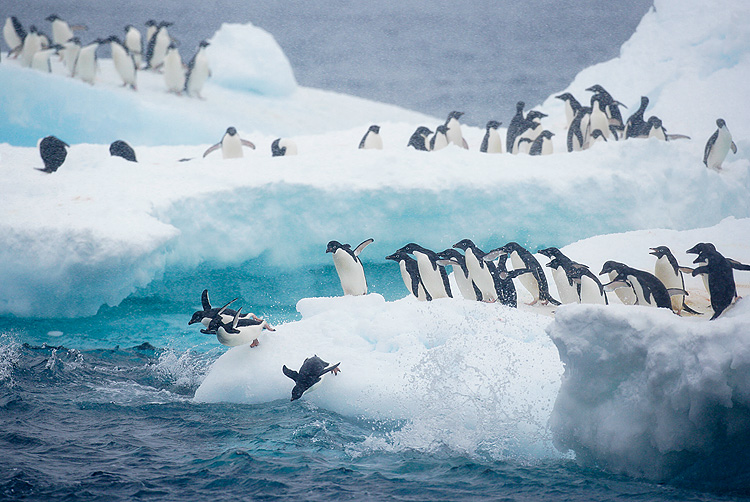 .
.
Adelie Penguins jumping off iceberg, Paulet Island, Antarctica
Image Copyright 2007: Arthur Morris/BIRDS AS ART
Canon 500mm f/4 L IS lens with EOS-1Ds Mark II. ISO 400.
Evaluative Metering +1 stop set manually: 1/1000 sec. at f/5.6.
It is rare that there is so much great stuff going on that I do not know what to photograph first but that is exactly what happened in the snow on Paulet Island. Using the 500 alone with the full frame sensor body allowed for the complete inclusion of the birds along the upper frame-edge.
THE DIRT ON LENS PENS!
Here is an e-mail exchange with Elinor Osborne:
Hi Elinor,
re
EO: I'm wondering if you have any more advice on sensor cleaning?
AM: I will try my best to help.
EO: At first, it seemed such a daunting task that (unfortunately) I didn't clean the sensor of my Canon EOS-1D Mark II sensor for quite some time.
AM: As you know, we recommend that folks clean the sensors of their digital cameras on a regular basis as—over time—some dust particles seem to become welded to the anti-aliasing filter that covers the sensor. Additionally, cleaning the sensor of a digital camera is no big deal. I have cleaned the sensors on all of my digital cameras more than a thousand times. The only problem that I ever encountered was when I scratched the sensor of an EOS 1Ds Mark II while using the wet method. (The Pec Pad that someone gave to me had some sort of particle on it; one swipe and there was a huge gouge on the anti-aliasing filter. Ooops.) I have never damaged a camera using the Lens Pen.
EO: When you recommended Lens Pens I tried them but had to resort to using the Visible Dust wet method and swipes to get the dust loosened.
AM: As we recommend in the instruction letter, you need to resort to one of the wet methods to remove “welded” dust particles.
EO: The dust is no longer stuck as it moves around with each Lenspen cleaning (There have been several recently for a duration of a couple of hours). I hold the camera upside down so the dust can fall out, use the blower brush before and after Len Pen cleaning, use firm pressure on the Lenspen, clean the sensor indoors away from air currents, and always shut the camera off before attaching the lens, but I never can get rid of all of the dust.
AM: It sounds as if you are doing everything right. Are you using a large Rocket Blower? If not, get one. If you are, it sounds as if you may not be holding the blower close enough to the anti-aliasing filter to blow the dust out. I hold the camera upside down at a slight angle, peek into the box from below, set the blower in place aiming at one of the four corners of the anti-aliasing filter about ½ inch or less from the filter, and then blow hard several times. Then I repeat that for each corner. Lastly I blow the whole chamber out. To sum up, the Lens Pen often loosens sensor dust; you then need to use the blower properly and efficiently to blow the loosened particles out of the chamber.
EO: Do you get the sensor 100% dust free or just tolerate some, taking care of it in PS later?
AM: I am able to get rid of most large dust spots using the Lens Pen more than 99% of the time. About 10% of the time I am able to get the sensor perfectly clean without a single dust spot visible at f/22 even in the corners (which are the toughest places to get clean). That said it is important to remember that you are making your before and after images at the smallest aperture; any dust spot, no matter how miniscule will be visible when you view the image in Photoshop. In practice, we make most of our wildlife images using relatively wide apertures. The small dust spots that are often visible in the corners of the frame at f/22 or f/32 will not be visible at all in images made at f/5.6, f/8, or even at f/11. When I work at smaller apertures, I sometimes need to remove the dust spots in Photoshop (as described in Digital Basics: http://www.birdsasart.com/lenspens.htm)
I hope that that helps.
Best and love, artie
For information on purchasing a Lens Pen Combo Kit and receiving our detailed instructions, click here: http://www.birdsasart.com/lenspens.htm
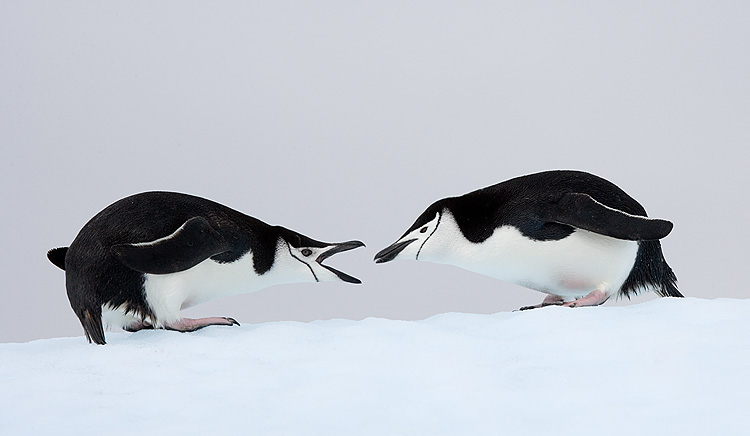
Chinstrap Penguins squabbling on iceberg near Coronation Island, South Orkney Islands
Image Copyright 2007: Arthur Morris/BIRDS AS ART
Canon 100-400mm IS L zoom lens handheld at 250mm with the EOS-1Ds Mark II. ISO 400.
Evaluative Metering +1 stop: 1/1250 sec. at f/11.
Most times I used 45-Point AFPS when working from the Zodiacs so that the system would hold focus as the boat was rocking in the waves.
GALAPAGOS 2007
Due to a cancellation, we have an opening for a female share on the long sold out July 18-28, 2007 Photo Cruise. The cost of this trip is $4499.00 per person based on double occupancy. For complete details, click here: http://www.birdsasart.com/bn200.htm. If you are interested, please call Janie Bullard immediately at 888-419-6677 (best to leave a message stating your intent) or email her at Janie@Distinctive-Journeys.com. If you are seriously interested, do not waste a moment.
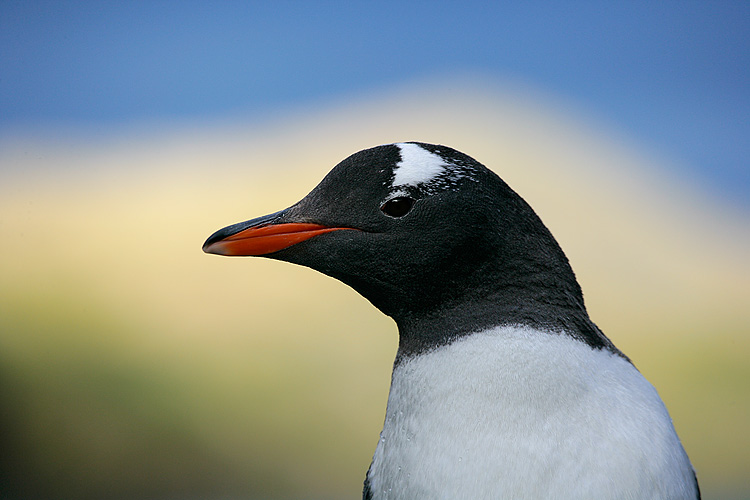
Gentoo Penguin, Stromness Bay, South Georgia
Image Copyright 2007: Arthur Morris/BIRDS AS ART
Canon 100-400mm IS L zoom lens handheld at 400mm with the EOS-1Ds Mark II. ISO 400.
Evaluative Metering +2/3 stop: 1/320 sec. at f/8.
When the sun hit the distant hill late in the afternoon I was desperate to include it in a composition so I got down on the ground and did just that with a cooperative gentoo. Subject in shade and background in sun is often a wonderful combination. In those situations you need to over-expose in order to prevent under-exposure of the subject.
NYC SEMINAR
Amazingly, we have already registered 44 folks for this event. There is a great possibility that this event will sell out well in advance. We can comfortably entertain 125 folks…
The Art of Nature Photography; It Ain’t Just Birds!
Weekend How-To Seminar
Queens, New York (near JFK Airport)
August 18-19, 2007
The cost of the weekend seminar will be $169. The cost of either single day will be $99. Members of qualifying camera clubs are invited to apply a $10 discount. (If you are a member of a camera club or other photography organization please e-mail for details.) Register with a friend or spouse and take $10 off each registration. Register in groups of four or more and take $20 off of each registration. Get a group of ten photographers together and apply a $30 discount to each registration. (Please e-mail for group registration details.) It is highly recommend that folks purchase the buffet luncheon option ($15/day includes tip and tax) as there are no fast food restaurants nearby. Those purchasing the lunch option will receive their lunch coupon when they check in each morning.) The cost of the weekend seminar plus the two lunches is $199.
To register, send a check for the full amount made out to "Arthur Morris" to PO Box 7245, Indian Lake Estates, FL 33855, call with a credit card: 863-692-0906, or send a Paypal (using either any link on our site or your Paypal account) to us at birdsasart@att.net In all cases, we will need your e-mail address, your mailing address, and your daytime and evening phone numbers. Here is our Cancellation Policy: If for any reason you need to withdraw, please notify us ASAP. Once we receive your e-mail, phone call, or written notice of your cancellation the following fees apply: cancel before May 17, 2007 and your fee will be refunded less a $20.00 cancellation fee; cancel by July 17, 2007 and your fee will be refunded less a $50.00 cancellation fee; cancel after July 17, 2007 and there will be no refund.
The doors will open on both days at 8 am and the programs will begin at 9 am sharp. There will be tons of great door prizes. I hope that you will be able to join me for what will be an incredibly educational and fun-filled weekend. (If anyone would like to help us set up or to simply hang out, be there at 7:00am.)
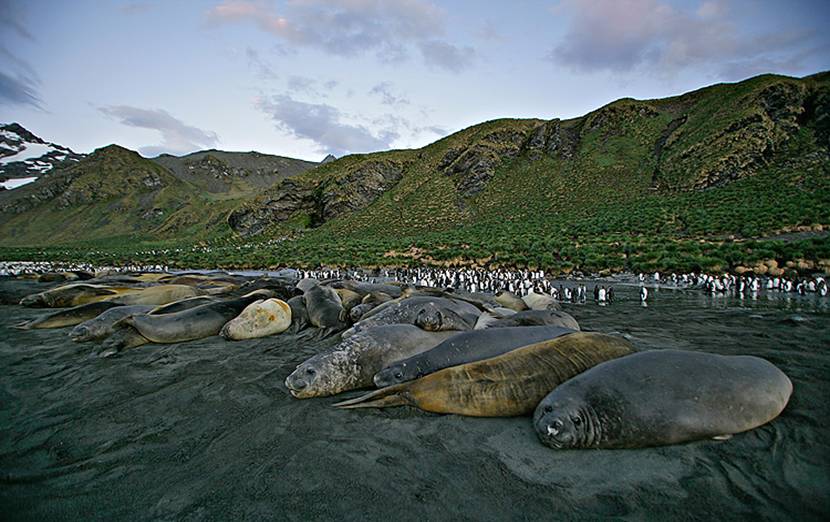
Southern Elephant Seals and King Penguins, Gold Bay, South Georgia
Image Copyright 2007: Arthur Morris/BIRDS AS ART
Canon 16-35mm zoom lens with EOS-1Ds Mark II. ISO 400.
1/125 sec. at f/3.2 set manually after histogram check.
I regretted having left the 15mm fish eye lens on my bunk when I got out of the Zodiac and saw a huge log pile of elephant seals. I borrowed a 16-35 zoom and came up with this one.
ADDITIONAL EVERGLADES NATIONAL PARK IN-THE FIELD WORKSHOP ANNOUNCED
The Saturday February 24, 2007 In-The-Field Workshop ($275 per person) is sold out with a waiting list. I am offering a second day of in-the-field instruction on Sunday February 25: Morning photo session at Shark Valley, afternoon photo session at Anhinga Trail. (Limit 12). To register, please send a check (made out to Arthur Morris) for payment in full to us at Arthur Morris/BIRDS AS ART, PO Box 7245, Indian Lake Estates, FL 33855. Paypals and phone credit cards payment are OK. Please be sure to include all contact info including home, work and cell numbers and most importantly, your e-mail address. Hope that you can join us.
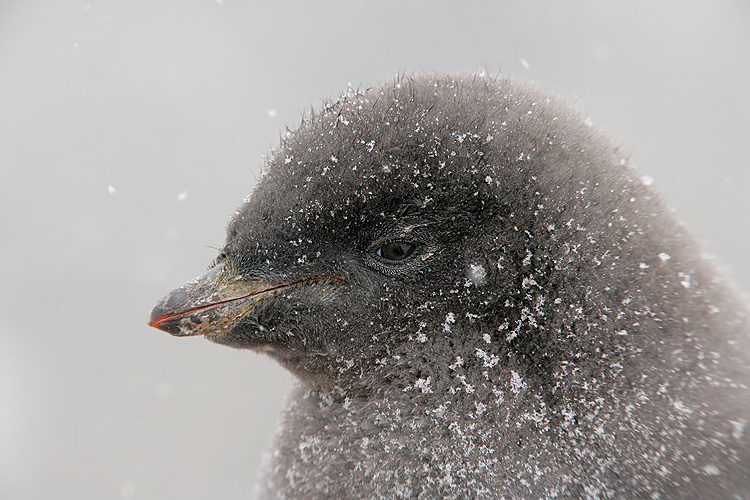
Adelie Penguin chick, head portrait in snow, Brown Bluff, Antarctica
Image Copyright 2007: Arthur Morris/BIRDS AS ART
Canon 500mm f/4 L IS lens with 1.4X II TC and EOS-1Ds Mark II. ISO 400.
Evaluative Metering +1 stop set manually: 1/320 sec. at f/8.
BIRDS AS ART/GUSTAPHOTO AFRICAN PHOTO SAFARIS
The trips that Todd Gustafson and I have been leading to both Kenya and Tanzania are getting so popular that all are filling years in advance. We strictly limit each trip to fifteen folks, with three photographers per van.
Kenya, SEP 10-27, 2007: 2 openings
Tanzania/Madagascar early FEB 2008: 2 openings
Kenya mid-AUG 2008: 2 openings
For additional information on any of the trips above, please contact me at birdsasart@att.net and copy Todd at Gustaphoto@aol.com. Todd will be in Tanzania until mid-February.
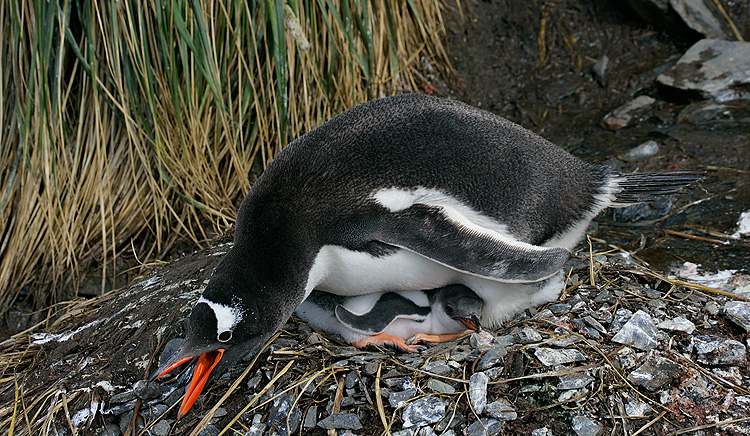
Gentoo Penguin on nest protecting chick, Gold Bay, South Georgia
Image Copyright 2007: Arthur Morris/BIRDS AS ART
Canon 100-400 mm f/4 L IS zoom lens with EOS-1Ds Mark II. ISO 400.
Evaluative Metering -1/3 stop: 1/500 sec. at f/13.
With a touch of sun it was necessary to underexpose a bit to avoid burning the whites.
IPT UPDATES
San Diego IPT: FEB 3-6, 2007. 4-FULL DAYS: $1359. Introductory slide program on the evening of Thursday, FEB 2. (Sold out) LaJolla, LaJolla Shores Beach, Coronado, and Santee Lakes. Brown Pelicans, Heerman’s & Western Gulls, Marbled Godwits & lots more shorebirds, Wood & Ring-necked Ducks & Lesser Scaup. And lots more.
SW FLA President's Holiday IPT: FEB 17-21, 2007. Slide program on the evening Friday, FEB 16, 2007. 5-DAY: $1649. (Limit 14; Sold out; wait list only.) Co-leaders: Robert O’Toole, Alfred Forns, & Robert Amoruso. Sanibel Island, Little Estero Lagoon, Venice Rookery, Cape Coral. Herons, egrets, gulls, terns, skimmers, shorebirds, both pelicans, Osprey, Burrowing Owl, and lots more.
Anhinga Trail In-The-Field Workshop: Saturday, February 24, 2007. $275. (Morning and afternoon photo sessions.) $275 per person (Sold out) Co-leaders Alfred Forns & Robert Amoruso. Join me for a rare east coast workshop at Everglades National Park. There will be tons of tame subjects and lots of great in-the-field instruction.
NEW! Shark Valley/Anhinga Trail In-The-Field Workshop: Sunday February 25, 2007. $275. (Morning—Shark Valley, and afternoon—Anhinga Trail photo sessions.) $275 per person (Limit 12) Co-leaders Alfred Forns & Robert Amoruso. Join me for a rare east coast workshop at Everglades National Park. There will be tons of tame subjects and lots of great in-the-field instruction.
Fort DeSoto IPT: APR 13-15, 2007. Slide program on the evening of Thursday, APR 12. 3-DAY: $999 Limit 14: (Sold out; wait list only) Co-leaders: Robert O’Toole, Alfred Forns, Robert Amoruso, and Todd Gustafson. Courtship and breeding behaviors of Laughing Gull and Royal and Sandwich Terns. Herons, egrets (including both dark and light phase Reddish Egret), shorebirds (including Long-billed Curlew), gulls, terns, and skimmers among others.
NEW! Fort DeSoto IPT: APR 17-19, 2007. Slide program on the evening of Monday, APR 16. 3-DAY: $999 Limit 14. Co-leaders: TBD. Courtship and breeding behaviors of Laughing Gull and Royal and Sandwich Terns. Herons, egrets (including both dark and light phase Reddish Egret), shorebirds (including Long-billed Curlew), gulls, terns, and skimmers among others.
NEW! St Augustine Alligator Farm MAY 17-20, 2007. 3 1/2 DAY IPT: $1099 (Limit: 12) Introductory Slide Program from 2-4pm on the afternoon of Thursday, May 17. This IPT includes 7 photography sessions and four slide programs, with at least two devoted totally to Photoshop. AMAZING HERON AND EGRET ROOKERY. NESTING GREAT, SNOWY & CATTLE EGRETS AND TRICOLORED HERONS WITH CHICKS.
Silver Salmon Creek: August 8-14, 2007. Coastal Brown Bears catching salmon, Horned Puffins, macro, scenics, and fishing (optional): $4999. (Limit 12: openings: 1; we need either a single female or a male, the latter most likely in a cabin) Three leaders, two TBA (plus me <smile>).
Bosque #1: "The Fall Color IPT" NOV 13-15, 2007. Slide Program on the evening of NOV 12. 3-DAY: $999. Limit 14. Co-leader: Robert O'Toole. This IPT should feature a better chance for a day or two of the rare south winds that drastically improve flight photography and will definitely feature the brightest fall-color cottonwoods.
Bosque #2: "The Pre-Thanksgiving IPT" NOV 18-20, 2007. Slide Program on the evening of NOV 17. 3-DAY: $999. Limit 14. Co-leader: Robert O'Toole & Alfred Forns. This IPT will feature increasing numbers of geese and cranes with lots of great opportunities. In 2007, I will again be hosting a Thanksgiving Day luncheon at Las Lunas Mansion, a fine restaurant in an historic building. You will need to reserve a spot and pay in advance. Details TBA; strictly limited to 50 folks.
Bosque #3: "The Post-Thanksgiving IPT" NOV 24-26, 2007. Slide Program on the evening of NOV 23. 3-DAY: $999. (Limit 14: 3 slots open) Assistant leaders: Robert O'Toole, Robert Amoruso, and Alfred Forns. This IPT is scheduled on dates that I consider peak for Bosque. (There may be a Full Moon Add-on NOV 23; details TBA. If you register for this one, hold off on buying your plane ticket if you might be interested in the add-on.) In 2007, I will again be hosting a Thanksgiving Day luncheon at Las Lunas Mansion, a fine restaurant in an historic building. You will need to reserve a spot and pay in advance. Details TBA; strictly limited to 50 folks.
SW FLA Post X-mas IPT: DEC 27-29, 2007. Slide program on the evening Wednesday, DEC 26, 2006. 3-DAY: $1029. (Limit 12) Co-leaders: Alfred Forns, & Robert Amoruso. Sanibel Island, Venice Rookery, Cape Coral, and possibly Little Estero Lagoon (depending on the tides). Herons, egrets, gulls, terns, skimmers, shorebirds, both pelicans, Osprey, Burrowing Owl, and lots more. Roseate Spoonbill and Wood Stork possible.
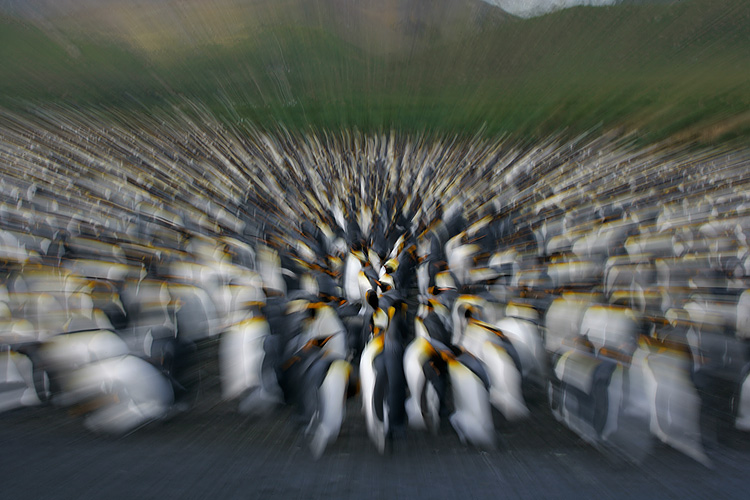
King Penguin rookery zoom blur, Gold Bay, South Georgia
Image Copyright 2007: Arthur Morris/BIRDS AS ART
Canon 100-400mm IS L zoom lens with EOS-1Ds Mark II. ISO 50.
Evaluative Metering +1/3 stop: 1/8 sec. at f/8.
Whenever I see large flocks of birds in low light I think zoom blur. Notice that I went all the way down to ISO 50 in order to have a slow enough shutter speed. To learn how to make zoom blurs see same in “Creating Pleasing Blurs” in ABP II: http://www.birdsasart.com/ABPII.htm
HUNT’S SPECIALS

Contact: Gary Farber, Tel#800-221-1830 ext. 2332, Fax#800-336-3841,
Email: DigitalGuyGary@wbhunt.com
BIRDS AS ART Specials (Expiration: February 19, 2007)
Hunt’s currently has in stock the Epson 3800 Printer. Inquire regarding the Birds as Art subscriber price.
Epson 2400 Printer……………………………………………………………$749.99
Ask about the price on inks and paper for the Epson 7800/9800/4800 Printers and on the Epson 7800/9800/4800 Printers.
Free shipping is being offered on all Bogen and Gitzo Tripods and LowePro Bags.
Greg Tag MacBeth Eye One Display 2……………………………………….$199.99
Ask about Birds as Art subscriber price on the Nikon D200 and 200-400 lens, all Nikon lenses, and Digital SLR Cameras.
Canon IP5000 Printer now is offering a $500.00 instant rebate. Call for the current price for subscribers.
Contact Gary at Hunt’s for pricing on all Canon lenses including the 500F4, 400F4 DO IS, 24-105, 100-400, 70-200 IS, 300 2.8L IS USM, 300F4 IS USM, 400 5 6L USM, Canon 700-200 F4 IS, and other Canon lenses and accessories.
During the month of March or April both Canon and Nikon will be coming out with new digital cameras and lenses. Birds as Art subscribers who may be interested in that particular equipment please send in your name, address, and telephone number. You will be notified with pricing and availability, and you will be placed on a priority list for shipment.
Contact Gary Farber for all you photo, video, and digital needs.
Best and love and great picture-making to all,
artie
Note: Arthur Morris has been a Canon contract photographer since 1994 and continues in that role today. Hunt's Photo of Boston, MA is a BAA sponsor as it Delkin Devices. Back issues of all BAA Bulletins can be found in the Bulletin Archives which may be accessed from the home page at www.birdsasart.com